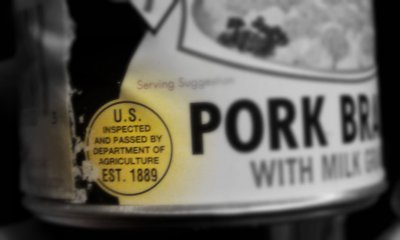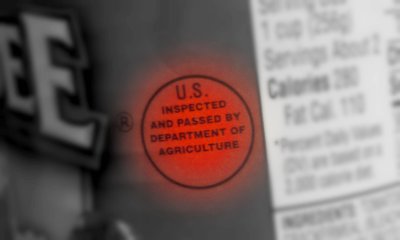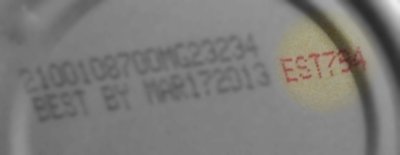The more you know about food labels and how to read them, the more you can make informed decisions about the products you buy. With that in mind, I'd like to show you an easy way you can discover where many of the canned, frozen, and otherwise processed foods you buy were manufactured. This is especially useful in the case of generic foods, many of which are packed for private labels by large, well-known national brands.
All processed foods containing meat for sale in interstate commerce are required to pass inspection by the USDA Food Safety and Inspection Service (FSIS). Companies producing the foods are assigned "Establishment Numbers" which appears on the label along with the inspection mark. The type of mark varies depending upon the type of meat in the product:
The first inspection mark - for raw beef, pork, lamb, and goat - was once commonly stamped on the fat side of the meat in purple ink, and if you're an old guy like me, you might remember having seen those marks or their remnants on the side of your steak or pork chop. Back in the days when meat was sold by the side and shipped whole to the butcher for cutting, those purple marks were very familiar to consumers. Nowadays, with meat pre-cut into primals and cryovac'd before shipping, the purple marks are rarer and the inspection marks often appear printed on the outside of the plastic wrap.
The second and third marks are commonly found on the labels and outer boxes of canned and frozen foods which contain meat and poultry. They are generally a standard size - about half an inch in diameter - and placed in an easy-to-find location on the label.
Remember how I mentioned that every processor has been assigned "Establishment Numbers?" Those numbers are the key to finding out which company processed the product, and at which plant it was done. The FSIS maintains directories in PDF and XLS format at this website. There are two files, one organized by establishment name, and the other by establishment number. I find the one sorted by number to be the most useful, since it's the number that appears on the mark. All you need to do is click on the link, bring up the file with Adobe Acrobat reader, and search by the number to find the name and address of the processor. And if you have a smartphone, it's even better: you can use your phone's browser to download the file of your choice and then use a PDF reader app to look up the establishment right there in the store.
Let me give you a couple of examples.
Here's the inspection mark on a can of Rose Pork Brains in Milk Gravy. The inspection mark says that this product was processed at Establishment 1889. Checking the FSIS directory, we find that Establishment 1889 is Bost Distributing Co. Inc, 2209 Boone Trail Rd., Sanford NC 27330, and that they own five labels, one of which is Foell Packing Company (the actual company listed on the Rose Pork Brains label.) The directory also lists the primary phone number of the company. It doesn't take much imagination to realize how useful this kind of information can be to the consumer.
Sometimes, a product will have an inspection mark without an establishment number printed inside it, like this one from a can of Chef Boyardee Meat Ravioli. This is most common on stuff processed by huge companies (such as ConAgra, in this case) which have many processing plants across the country.
When you find an inspection mark like this, look at the ends of the can or box for the production codes, which will be either printed there or stamped into the packaging. That's where you'll find the establishment number - in this case, Est. 794. This can of Chef was processed by ConAgra at their plant located at 30 Marr Street in Milton, Pennsylvania.
Okay, so now I've shown you how to use the inspection marks to find out a bunch of information about where the stuff in your pantry and freezer is coming from. And that brings me to a hugely practical application of this info: Finding out who is really behind the store brands and generics that you might want to buy to save a few bucks on your grocery bill. You may remember this post from November 2010 reviewing ALDI's Kirkwood Brand frozen fried chicken. I thought it tasted just like ConAgra's Banquet frozen fried chicken - and it turned out that it really was just like Banquet. ConAgra processes Kirkwood chicken for ALDI at establishment P-7131 in Batesville Arkansas. The biggest difference between the two brands of chicken? The price, of course - Kirkwood sells for up to $2.00 a box less than Banquet.
Links and other useful information:
Click here to go directly to the download page for the USDA Food Safety and Inspection Service's Meat, Poultry and Egg Product Inspection Directory. The directories are downloadable from that page. The USDA periodically updates the directory, so if you choose to download it to your smartphone for mobile use, you may want to sign up for email notification of new files using the link provided there.
Click here for the home page of the USDA FSIS. There are tons of links there, with information available on food safety education, product recalls, Q&A board, and more.
Let me give you a couple of examples.
Here's the inspection mark on a can of Rose Pork Brains in Milk Gravy. The inspection mark says that this product was processed at Establishment 1889. Checking the FSIS directory, we find that Establishment 1889 is Bost Distributing Co. Inc, 2209 Boone Trail Rd., Sanford NC 27330, and that they own five labels, one of which is Foell Packing Company (the actual company listed on the Rose Pork Brains label.) The directory also lists the primary phone number of the company. It doesn't take much imagination to realize how useful this kind of information can be to the consumer.
Sometimes, a product will have an inspection mark without an establishment number printed inside it, like this one from a can of Chef Boyardee Meat Ravioli. This is most common on stuff processed by huge companies (such as ConAgra, in this case) which have many processing plants across the country.
When you find an inspection mark like this, look at the ends of the can or box for the production codes, which will be either printed there or stamped into the packaging. That's where you'll find the establishment number - in this case, Est. 794. This can of Chef was processed by ConAgra at their plant located at 30 Marr Street in Milton, Pennsylvania.
Okay, so now I've shown you how to use the inspection marks to find out a bunch of information about where the stuff in your pantry and freezer is coming from. And that brings me to a hugely practical application of this info: Finding out who is really behind the store brands and generics that you might want to buy to save a few bucks on your grocery bill. You may remember this post from November 2010 reviewing ALDI's Kirkwood Brand frozen fried chicken. I thought it tasted just like ConAgra's Banquet frozen fried chicken - and it turned out that it really was just like Banquet. ConAgra processes Kirkwood chicken for ALDI at establishment P-7131 in Batesville Arkansas. The biggest difference between the two brands of chicken? The price, of course - Kirkwood sells for up to $2.00 a box less than Banquet.
Links and other useful information:
Click here to go directly to the download page for the USDA Food Safety and Inspection Service's Meat, Poultry and Egg Product Inspection Directory. The directories are downloadable from that page. The USDA periodically updates the directory, so if you choose to download it to your smartphone for mobile use, you may want to sign up for email notification of new files using the link provided there.
Click here for the home page of the USDA FSIS. There are tons of links there, with information available on food safety education, product recalls, Q&A board, and more.





Dude, useful post!
ReplyDeleteI'm always buying stuff at the Dollar Tree that is ambiguous about its place of origin.
Like, it'll say, "Distributed by Colfax Foods, of Westport Virginia," but it doesn't say anywhere on the package where the item was actually MADE.
Interesting.
More info on the use of the stamps (USDA regulations)
ReplyDeleteRed meat: http://edocket.access.gpo.gov/cfr_2010/janqtr/pdf/9cfr312.2.pdf
Poultry: http://edocket.access.gpo.gov/cfr_2009/janqtr/pdf/9cfr381.96.pdf
Labeling requirement regulations, including nutritional claims: http://www.access.gpo.gov/nara/cfr/waisidx_09/9cfr317_09.html
A fun page here too, how the USDA defines meat products.
Standards of idenity: http://www.access.gpo.gov/nara/cfr/waisidx_09/9cfr319_09.html
Does anybody know where Shaklee Baby food is made and does FDA play any role in this.
ReplyDelete